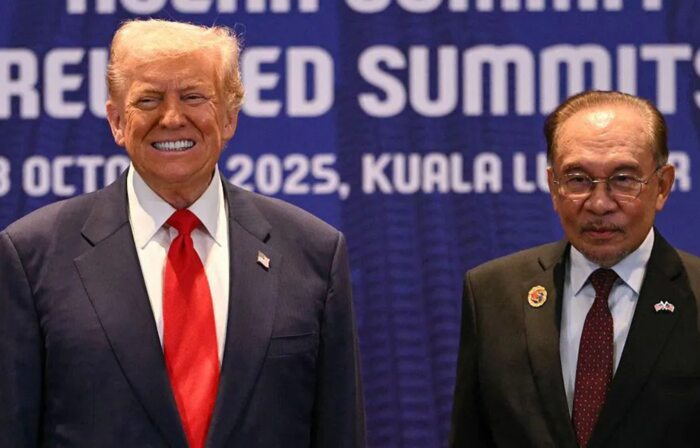As U.S. President Donald Trump boarded Air Force One in Kuala Lumpur, his 24-hour visit to Southeast Asia wrapped up with a series of bold declarations and headline-making deals. According to the White House, the visit brought “peace and prosperity” to the region—while also giving the ASEAN Summit its most high-profile moment in years.
Now, as Trump travels on to Japan and South Korea for a much-anticipated meeting with Chinese President Xi Jinping, the once-overlooked Association of Southeast Asian Nations (ASEAN) suddenly finds itself in the international spotlight.
Trump’s Claim of a ‘Peace Deal’ Between Thailand and Cambodia
The most talked-about moment of Trump’s visit came when he presided over what he called a “peace deal” between Thailand and Cambodia, nations that recently clashed over a long-standing border dispute.
While Thai officials hesitated to label it a peace agreement, the truce marked a rare diplomatic win for ASEAN and its chair, Malaysian Prime Minister Anwar Ibrahim. Anwar, a seasoned politician, used his regional connections and diplomacy to bring both sides to the table—and reportedly even managed to lighten the atmosphere with a playful joke about Trump’s legal troubles.
Still, U.S. influence was undeniable. Sources suggest that American economic pressure—and Trump’s willingness to threaten trade consequences—was a key factor in getting both sides to cease hostilities.
Trade Talks and Strategic Diplomacy
The so-called peace deal was followed by the announcement of several U.S. trade agreements with Thailand and Cambodia. Trump made it clear that economic cooperation could serve as leverage for regional stability.
For ASEAN leaders, his visit was a golden opportunity to secure face time with Washington during a critical moment in ongoing U.S. tariff negotiations. Export-driven economies like Vietnam, Malaysia, and Thailand depend heavily on U.S. markets. While tariff reductions were off the table, leaders successfully negotiated product exemptions, softening the impact of U.S. trade measures.
“Trump was here for a photo op—another feather in his cap,” said Joseph Liow, Dean of the Lee Kuan Yew School of Public Policy in Singapore. “But since he was here, Asian leaders wisely used the opportunity to highlight shared U.S.-Asia interests.”
ASEAN’s Role: Relevance Under Pressure
Founded in 1967 to counter the spread of communism, ASEAN has evolved into a platform for diplomacy and trade. Its strength lies in its ability to gather global powers under one roof. This year, the summit welcomed leaders from China, the European Council, Canada, Brazil, and South Africa, alongside Trump.
However, critics have long accused ASEAN of being ineffective when dealing with regional crises. Despite success in fostering economic cooperation and free trade, it has struggled with major issues—from Myanmar’s civil conflict and air pollution from Indonesian forest fires to territorial disputes in the South China Sea.
ASEAN’s failure to end Myanmar’s civil war, now raging for four years, remains its biggest embarrassment. Even during this summit, the bloc’s call for the junta to end violence and allow “free and fair elections” was ignored.
Why ASEAN Is Often Called ‘Toothless’
Unlike the European Union or NATO, ASEAN has no military or binding enforcement powers. Its most powerful weapon is diplomacy—one constrained by its core policy of non-interference in members’ internal affairs.
Critics argue this principle limits the organization’s effectiveness. “When it comes to political crises, it’s mission impossible for members to give up sovereignty,” explained Huong Le Thu, Deputy Director of the Asia Programme at the International Crisis Group.
Still, Trump’s high-profile involvement in the Thailand-Cambodia ceasefire offers ASEAN a small but meaningful win—proof that it can still influence peace when backed by external power.
New Partnerships and A Historic Membership
Beyond peace efforts, the Kuala Lumpur summit also delivered progress in U.S.-China trade relations. U.S. Treasury Secretary Scott Bessent met with Chinese Vice Premier He Lifeng to establish a “framework deal” on rare earths and tariffs—a move seen as a positive step ahead of Trump’s meeting with Xi Jinping at the APEC Summit in South Korea.
In another symbolic victory, ASEAN officially welcomed East Timor (Timor-Leste) as its newest member. The addition completes Southeast Asia’s geographic representation under the bloc.
“Joining ASEAN is a dream realized,” said Prime Minister Xanana Gusmão of East Timor, as his delegation tearfully celebrated the milestone. The emotional moment—widely shared online—was a reminder that, despite criticism, ASEAN still holds power as a symbol of unity and progress.
Trump’s Visit: Symbolism or Substance?
For Trump, the ASEAN stopover checked several boxes: a photo opportunity, a foreign policy victory, and a chance to claim another “peace achievement.” For ASEAN, it was a reminder that even a “toothless” organization can still matter on the world stage—especially when its unity is tested.
Whether this summit marks a turning point or just another fleeting diplomatic headline remains to be seen. But one thing is clear: ASEAN, with the right mix of global attention and regional leadership, can still find its voice.
Conclusion
The 2025 ASEAN Summit in Kuala Lumpur might not have solved all of Southeast Asia’s problems—but it proved that the bloc is still capable of relevance and results. From a symbolic peace deal to renewed trade talks and new membership, the event reminded the world that even amid criticism, ASEAN remains a critical bridge for dialogue and diplomacy.
For more world and regional updates like this, visit the DiversityNewsMagazine News section —your trusted source for trending stories across culture, politics, and global affairs.
Photo Credit: Getty Images


